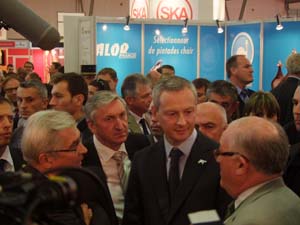Crisis causes uncertainty among French egg producers

The 25th edition of the annual French livestock show, SPACE, was well attended. Despite the uncertain financial situation many poultry farmers expressed an interest in new developments. Especially egg producers took the opportunity to share their feelings about the economic crisis, the low egg prises and the conversion of their housing systems in order to meet the EU animal welfare regulations.
By Wiebe van der Sluis
Many French egg producers are still struggling to adjust their hen housing system in agreement with the EU welfare regulations. The deadline of 1-1-2012 is looming and there are many who are not ready yet. This was visible at the 25th SPACE, the international livestock show held every year in September in Rennes. The event attracted 1300 exhibitors of which 380 came from outside France and more than 108,000 visitors (an increase of 1.5% on 2010) including 10,045 (an 8% increase) international visitors.
Free range and community cages
Although the majority of the show focuses on other sectors of the agri-business, poultry gets its fair share of attention. This year the poultry section was well attended, although the egg producers had little reason to show a spending interest. The EU egg market is tough and for quite some time did not provide a fair price for eggs. In addition, due to the global economic crisis, banks have become very reluctant to provide loans for new investments. This is causing stress among the egg producers that have not yet converted their hen housing system in line with the EU laying hen welfare regulation which bans the use of traditional battery cages.
Although the majority of the show focuses on other sectors of the agri-business, poultry gets its fair share of attention. This year the poultry section was well attended, although the egg producers had little reason to show a spending interest. The EU egg market is tough and for quite some time did not provide a fair price for eggs. In addition, due to the global economic crisis, banks have become very reluctant to provide loans for new investments. This is causing stress among the egg producers that have not yet converted their hen housing system in line with the EU laying hen welfare regulation which bans the use of traditional battery cages.
Like in most other European countries, many French producers who do not have a successor or the financial resources, made the decision to stop production but continue producing until whenever possible. Those who stay in business have already changed their housing system or are in the process of doing so. Initially the focus of all egg producers was on aviary or free range systems, but over time the interest for extended or colony cage systems grew. Several exhibitors showed their enlarged and community cages. There seems to be a trend to enlarge the community cages. Where 30-36 birds used to be a normal number of hens in a group, various companies now offer systems of up to 50-60.
Poultry equipment manufacturer, Salmet is enjoying heightened interest in their enlarged community cage system in which up to 48 birds can be kept. Trials show good results in bird performance and bird welfare, while in larger groups there are more signs of feather pecking. The interest in community cage systems comes mainly from larger producers and producers that have a demand for high quality, hygienic and safe eggs.
Most cage manufacturers do not exhibit traditional cages any more, but remarked that they still receive interest in these cages from visitors from Africa and Asia.
InnovSpace
Next to alternatives for layer cages an increasing number of companies presented cage systems for broilers. These systems are receiving an increasing interest, due to the excellent bird performance and health. The cages, often provided with soft flooring, keeps the birds away from their litter, which in fast growing birds is causing less coccidiosis and e-coli as well as leg and footpad problems. Most of the interest comes from Russia, Asia and the Middle East.
Next to alternatives for layer cages an increasing number of companies presented cage systems for broilers. These systems are receiving an increasing interest, due to the excellent bird performance and health. The cages, often provided with soft flooring, keeps the birds away from their litter, which in fast growing birds is causing less coccidiosis and e-coli as well as leg and footpad problems. Most of the interest comes from Russia, Asia and the Middle East.
To improve duck welfare, FAF le Rêve introduced a ventilation system which brings fresh air directly into the coops by means of a cylindrical fan. The air is drawn from the centre over the back and head of the birds to assure an even air distribution throughout the whole house. The innovative system requires 50% less energy and provides 50% less noise. These attributes convinced the InnovSpace jury to award this product with three stars, which was the highest honour given for product innovations this year.
One star was given to Actini for their Ovoflash egg pasteurisation system. It kills all salmonella bacteria possible present in liquid eggs at a temperature of 74°C without causing any damage to the egg white properties. Usually egg white starts to coagulate at 60°C but through using intelligent circulation and flow density technology the increased heat does not cause changes in the functional properties of the egg. This allows the user to extend the shelf life of liquid eggs to 10-12 weeks, without any chance of destruction by harmful micro-organisms.
Dimmable LED lamps
New to the French market are the dimmable LED lamps made by Glo Lighting from the UK and distributed by Plasson. Special attention was given to the AgriLamp 30W dimmable broiler lamp. It delivers a controllable, evenly distributed light that completely removes dark areas, providing a uniform distribution for rearing day olds to fully grown quality birds. It has been designed specifically to provide wavelength and intensity for broilers in all broiler houses, making it a true alternative to 100-150W incandescent, compact fluorescent (CFL) and fluorescent tubes. The lamp dramatically reduces lighting-related energy consumption by up to 90%, and each bulb is estimated to save farmers money in energy costs.
New to the French market are the dimmable LED lamps made by Glo Lighting from the UK and distributed by Plasson. Special attention was given to the AgriLamp 30W dimmable broiler lamp. It delivers a controllable, evenly distributed light that completely removes dark areas, providing a uniform distribution for rearing day olds to fully grown quality birds. It has been designed specifically to provide wavelength and intensity for broilers in all broiler houses, making it a true alternative to 100-150W incandescent, compact fluorescent (CFL) and fluorescent tubes. The lamp dramatically reduces lighting-related energy consumption by up to 90%, and each bulb is estimated to save farmers money in energy costs.
Poultry farmers have the additional reassurance that the AgriLamp has an expected lifespan in excess of 35,000 hours to 75% of its original output (10 times longer than incandescent light bulbs), bringing with it long-term cost savings. Furthermore, the AgriLamp has the lowest CO2 emissions of any lighting technology on the market, is non-toxic and can be safely and easily recycled. In addition the lamp is shock proof (and picking proof) as demonstrated by John Matcham, sales director of Glo Lighting, who was playing football with it.
This year SPACE reprinted the posters announcing the first-ever edition of the show in 1987. It showed Brittany as part of France, and pigs, sheep, cattle heading towards its capital Rennes. A perfect picture of the situation at the time, indicates Jean-Michel Lemetayer, president of SPACE since the show’s first edition.
In 1987, no major trade show existed in the area where 70% of the country’s poultry producers and also many pigs and dairy producers were located. “The objective was to create a professional show, with a focus on innovations and different from a public fair.” The Salon de la Production Animale – Carrefour Européen (Show for Animal Production – European Crossroads) came into existence.
The first edition attracted 260 exhibitors and 32,000 visitors – for Lemetayer ‘evidently’ the proof that the show has served a market from the very beginning. The 2011 version proved the formula has continued to perform well, as many people at the show spoke about how SPACE has grown to become Europe’s second-largest livestock show after EuroTier.
The 25th edition again attracted more visitors than last year: 108,907 with over 10,000 from over hundred countries. French agriculture will continue to develop – very likely there will be an ongoing need for SPACE in the next 25 years, Lemetayer told World Poultry. “I do not have a crystal ball of course – but for producers it remains important to learn about new techniques. Agriculture, modernity, quality, that will continue to be our drivers.”













